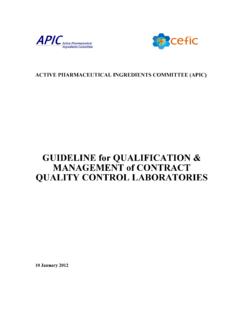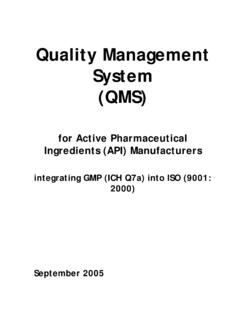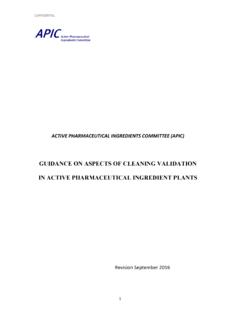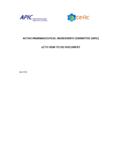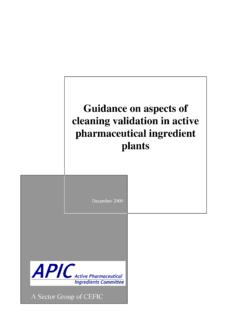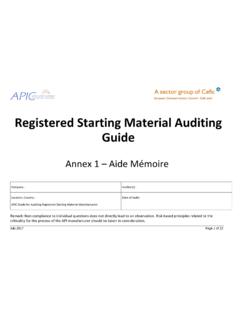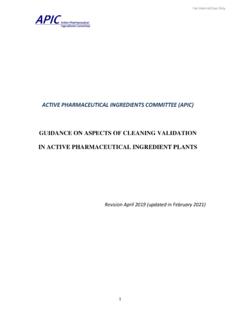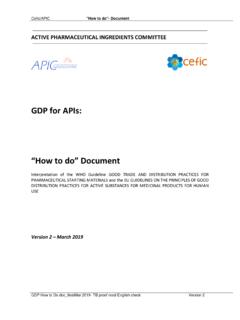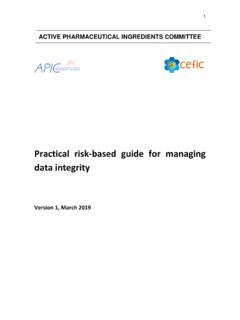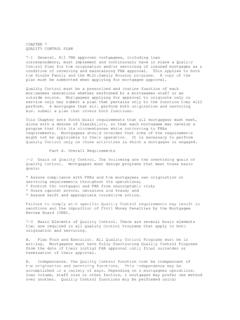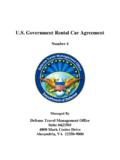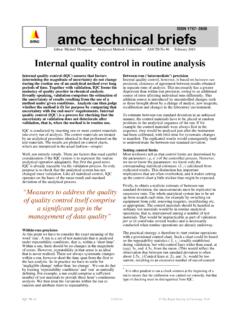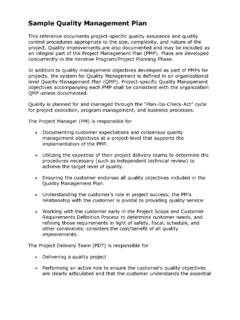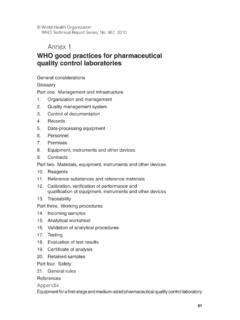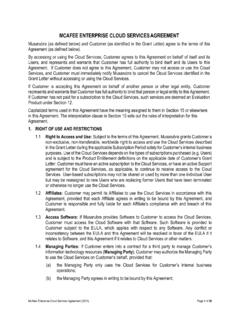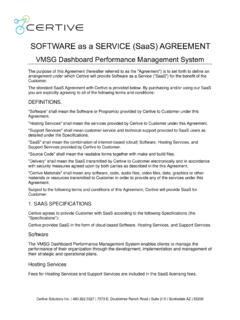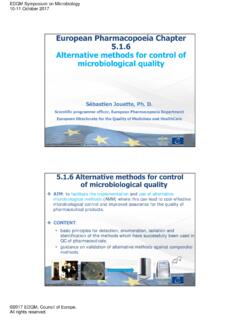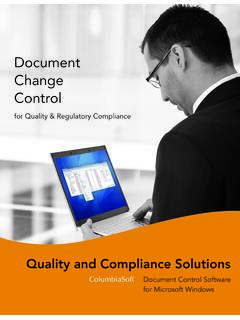Transcription of Quality Agreement for Laboratories Guideline Templates
1 _____ Copyright 2012 Active Pharmaceutical Ingredients Committee (APIC) ACTIVE PHARMACEUTICAL INGREDIENTS COMMITTEE (APIC) Quality Agreement for Laboratories Guideline & Templates _____ Copyright 2012 Active Pharmaceutical Ingredients Committee (APIC) Version April 2012 APIC Quality Agreement Guideline for Laboratories _____ Copyright 2012 Active Pharmaceutical Ingredients Committee (APIC) Version April 2012 Page 3/20 Disclaimer This document represents voluntary guidance for API manufacturers and their Contract Laboratories and the contents should not be interpreted as regulatory requirements. Alternative approaches than those described here may be used. Foreword The CEFIC* Sector Group APIC (the Active Pharmaceutical Ingredients Committee) was founded in 1992 as a direct consequence of the rapidly increasing European regulatory requirements affecting the manufacture of Active Pharmaceutical Ingredients (APIs).
2 APIC represents producers of APIs and API intermediates in Europe. Its membership consists of more than 60 companies, located all over Europe, and of several national industry associations. For around 2/3 of its members, selling APIs and intermediates is their major business while ca. 1/3 of the members are primarily marketing final medicinal products. APIC s focus is on worldwide Quality , Good Manufacturing Practice (GMP) and Regulatory matters relating to APIs and intermediates. Through the years APIC has developed into a high-profile industry association with an excellent, worldwide reputation. APIC has already developed a series of guidance documents and position papers (see ). This document offers best industry practice and guidance in the establishment of a Quality Agreement between an API manufacturer and its contract laboratory. The Guideline highlights the factors to consider when concluding such an Agreement between both parties.
3 If you have any comments or suggestions for further improvement please contact the APIC Secretary at: CEFIC Active Pharmaceutical Ingredients Committee (APIC) Av. E. Van Nieuwenhuyse 4 / box 2 B - 1160 Brussels Tel: +32 2 676 72 02 or +32 2 676 72 44 Fax: + 32 2 676 73 59 E-mail : or * CEFIC (the European Chemical Industry Council): The Brussels-based organisation that represents the European Chemical Industry APIC Quality Agreement Guideline for Laboratories _____ Copyright 2012 Active Pharmaceutical Ingredients Committee (APIC) Version April 2012 Page 4/20 Content 1. Acknowledgements 2. Introduction What is a Quality Agreement The Issue The solution 3. Purpose and Scope Purpose Scope 4. Legal Requirements 5. Format and Structure of a Quality Agreement General Aspects Standard Structure 6. Quality Agreement Review and Maintenance Negotiation, Review, and Approvals Maintaining Agreements 7.
4 References 8. Glossary Quality Agreement for Contract Laboratory Work APIC Quality Agreement Guideline for Laboratories _____ Copyright 2012 Active Pharmaceutical Ingredients Committee (APIC) Version April 2012 Page 5/20 1. Acknowledgements This document was developed by a group of experts within CEFIC / APIC. We cordially thank them for their hard work, efforts spent and their kind cooperation, intensive discussions and fruitful comments: Eileen COUNIHAN Merck Sharp & Dohme (IE).. Catherine DESAUTELS Lallemand SAS (FR) Rainer BASF SE Wolter FINSTER DSM Fine Chemicals (A) Fergal KELLY SWORDS Laboratories (IE) Michaela MARX Merck KGaA (DE) Ian MOORE Croda Chemicals Ltd (UK) Luisa PAULO Hovione (PT) Martin RIESER Siegfried AG (CH) Stephan ROSENBERGER Lonza AG (CH) Claudia STAMPFLI Lonza AG (CH) Tony STOREY Pfizer (UK) Fran ois VANDEWEYER Janssen Pharmaceutica (BE) Lore VIGNOLI Roquette Fr res (FR) We also like to thank anybody else who has, as a Quality or regulatory professional from pharmaceutical industry or as member of any industry association, given valuable input to the generation of this document.
5 APIC Quality Agreement Guideline for Laboratories _____ Copyright 2012 Active Pharmaceutical Ingredients Committee (APIC) Version April 2012 Page 6/20 2. Introduction One of the biggest issues facing the pharmaceutical industry and patients today is Quality , integrity and security of the pharmaceutical supply chain. As outsourcing of services such as analytical work along the supply chain is a common practice Supplier Quality Management have come into focus in the recent past. A suitable supplier qualification program has hence to be implemented by each user of purchased services. A major element of such a supplier qualification program is the Quality Agreement between the manufacturer of the API/intermediate and the contract laboratory in order to increase transparency and traceability. What is a Quality Agreement ? A Quality Agreement under the scope of this Guideline is a legally binding Agreement that is mutually negotiated and concluded between (the Quality Departments of) the service requestor and the Quality responsible at the service providing laboratory.
6 It is intended to define, in a formalised manner, responsibilities relative to Quality tasks to assure the supply of safe materials (APIs or intermediates) acceptable for pharmaceutical use. A Quality Agreement is based on the Quality procedures in place at both the service requestor and the service providing laboratory. The Quality Agreement also includes commitments between the parties regarding (a) the provision of information, documents, or samples, and (b) communication and notification rules including contacts. It creates mutual understanding of the Quality & regulatory requirements relevant to the analysis of material and both parties respective obligations related to Quality . By clearly delineating responsibilities, costly product Quality issues resulting from miscommunication can be reduced or eliminated. A Quality Agreement is a major element of a supplier qualification program but, of course, it is not a substitute for the supplier qualification processes, including audits as necessary, and for understanding the supplier processes and capabilities.
7 A Quality Agreement must not contain any commercial or liability related terms, which should exclusively be dealt with in a Supply Agreement . The Issue Due to the increasing desire to have Quality Agreements in place, there has been a trend to use Templates to get a large number of agreements in place quickly. Many companies have developed their own generic Quality Agreement Templates . Unfortunately, these individual Templates have often been designed to cover multiple types of services (stability testing, raw material testing, API testing) or products (APIs, intermediates, pharmaceutical excipients, and even packaging components). As a consequence, there have been extensive discussions between companies, and significant time and resources spent during all the review loops. At the end the complexity on both sides has considerably increased due to the high degree of diversity of agreements to be maintained.
8 It is a real challenge for all organisations to keep control over all the individual agreements and commitments made between the various parties (as regards, , timelines, document provisions, notifications vs. prior approvals). APIC Quality Agreement Guideline for Laboratories _____ Copyright 2012 Active Pharmaceutical Ingredients Committee (APIC) Version April 2012 Page 7/20 The Solution The issues mentioned above could be resolved by the use of standardised Templates . Since APIC is committed to improve the relationship between the different stakeholders in the production process of safe API, APIC has developed this Quality Agreement Guideline including the corresponding Templates . The APIC Task Force that did the work consisted of members from both specialised API/intermediate manufacturers and companies primarily making finished drug products. Hence APIC believes that the result represents best industry practice considering the needs and requirements that enter into such a Quality Agreement .
9 APIC Quality Agreement Guideline for Laboratories _____ Copyright 2012 Active Pharmaceutical Ingredients Committee (APIC) Version April 2012 Page 8/20 3. Purpose and Scope Purpose This document intends to provide expert guidance to the Analytical Laboratories analysing APIs and intermediates and its customers for the implementation and maintenance of appropriate Quality Agreements. It is obvious that consistent standards for such agreements will provide the following benefits to the industry: Lower workload (by reduced drafting time) Faster implementation (by reduced review times) Less complexity (by reduced diversity) Clear roles and responsibilities Compliance with current regulations Following this document will provide the state of the art for Quality Agreements for analytical services in the pharmaceutical (API/intermediate) supply chain.
10 The APIC Quality Agreement Guideline and corresponding Templates are designed to be a flexible model for preparing Quality Agreements. It defines the appropriate items that should be addressed in a Quality Agreement . The template is designed to be global in scope and contents, thus being suitable for the use in all regions. Scope The Guideline and Templates cover agreements between the API/intermediate manufacturer and the Analytical Laboratory providing any kind of analytical service. It does not cover agreements between API/intermediate manufacturer and their customers. APIC Quality Agreement Guideline for Laboratories _____ Copyright 2012 Active Pharmaceutical Ingredients Committee (APIC) Version April 2012 Page 9/20 4. Legal Requirements Although Quality Agreements have become a common tool in our business and are intensively demanded by the authorities to be implemented they are not described in broad in the current guidelines.
